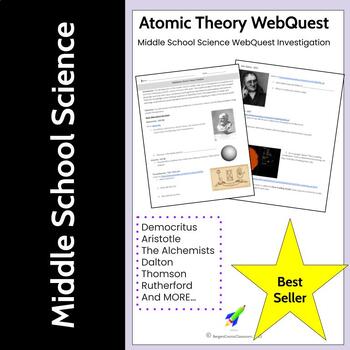Atomic Theory Timeline WebQuest
Bergers Cosmic Classroom
24 Followers
Grade Levels
6th - 11th
Subjects
Resource Type
Standards
CCSSRI.K.1
CCSSCCRA.L.4
NGSSMS-PS1-1
Formats Included
- PDF
- Webquests
Pages
6 pages
Bergers Cosmic Classroom
24 Followers
Compatible with Digital Devices
The Teacher-Author has indicated that this resource can be used for device-based learning.
What educators are saying
I used this resource with 9th grade physical science students. Students were engaged and found this resource useful.
Description
Tried of having students to tedious and time consuming timeline posters? Are those digital timeline tools just too much to figure out? Then this product is for you! I put together an activity that goes through all the major contributors to the atomic theory. (Democritus, Aristotle, The Alchemists, John Dalton, JJ Thomson, Ernest Rutherford, Bohr, Chadwick, and Schrodinger)
Students use websites, videos, and simulations in order to answer key questions about the contributors to the atomic theory. The final page of the document includes key vocabulary about atoms, elements, and compounds.
Answer key not included**
Total Pages
6 pages
Answer Key
N/A
Teaching Duration
90 minutes
Report this resource to TPT
Reported resources will be reviewed by our team. Report this resource to let us know if this resource violates TPT’s content guidelines.
Standards
to see state-specific standards (only available in the US).
CCSSRI.K.1
With prompting and support, ask and answer questions about key details in a text.
CCSSCCRA.L.4
Determine or clarify the meaning of unknown and multiple-meaning words and phrases by using context clues, analyzing meaningful word parts, and consulting general and specialized reference materials, as appropriate.
NGSSMS-PS1-1
Develop models to describe the atomic composition of simple molecules and extended structures. Emphasis is on developing models of molecules that vary in complexity. Examples of simple molecules could include ammonia and methanol. Examples of extended structures could include sodium chloride or diamonds. Examples of molecular-level models could include drawings, 3D ball and stick structures, or computer representations showing different molecules with different types of atoms. Assessment does not include valence electrons and bonding energy, discussing the ionic nature of subunits of complex structures, or a complete depiction of all individual atoms in a complex molecule or extended structure.





